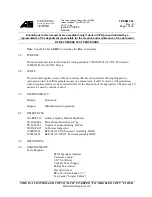
8 Programming: Cycles
8.3 Cy
cles f
o
r Dr
illing, T
a
pping and Thr
ead Milling
RIGID TAPPING without a floating tap holder
TAPPING (Cycle 207)
The TNC cuts the thread without a floating tap holder in one or more
passes.
Rigid tapping offers the following advantages over tapping with a
floating tap holder:See “RIGID TAPPING (Cycle 17),” page 229.
1
The TNC positions the tool in the tool axis at rapid traverse FMAX
to the programmed setup clearance above the workpiece surface.
2
The tool drills to the total hole depth in one movement.
3
Once the tool has reached the total hole depth, the direction of
spindle rotation is reversed and the tool is retracted to the set-up
clearance at the end of the dwell time. and — if programmed — to
the 2nd set-up clearance with FMAX.
4
The TNC stops the spindle turning at set-up clearance.
Machine and control must be specially prepared by the
machine tool builder for use of this cycle.
Before programming, note the following:
Program a positioning block for the starting point (hole
center) in the working plane with radius compensation R0.
The algebraic sign for the parameter total hole depth
determines the working direction.
The TNC calculates the feed rate from the spindle speed.
If the spindle speed override is used during tapping, the
feed rate is automatically adjusted.
The feed-rate override knob is disabled.
At the end of the cycle the spindle comes to a stop. Before
the next operation, restart the spindle with M3 (or M4).
Summary of Contents for TNC 426
Page 3: ......
Page 4: ......
Page 8: ...IV...
Page 10: ...VI...
Page 26: ......
Page 27: ...1 Introduction...
Page 41: ...2 Manual Operation and Setup...
Page 54: ......
Page 55: ...3 Positioning with Manual Data Input MDI...
Page 59: ...4 Programming Fundamentals of NC File Management Programming Aids Pallet Management...
Page 122: ......
Page 123: ...5 Programming Tools...
Page 153: ...6 Programming Programming Contours...
Page 201: ...7 Programming Miscellaneous functions...
Page 226: ......
Page 227: ...8 Programming Cycles...
Page 366: ......
Page 367: ...9 Programming Subprograms and Program Section Repeats...
Page 381: ...10 Programming Q Parameters...
Page 424: ......
Page 425: ...11 Test run and Program Run...
Page 443: ...12 MOD Functions...
Page 472: ......
Page 473: ...13 Tables and Overviews...
Page 496: ......
















































